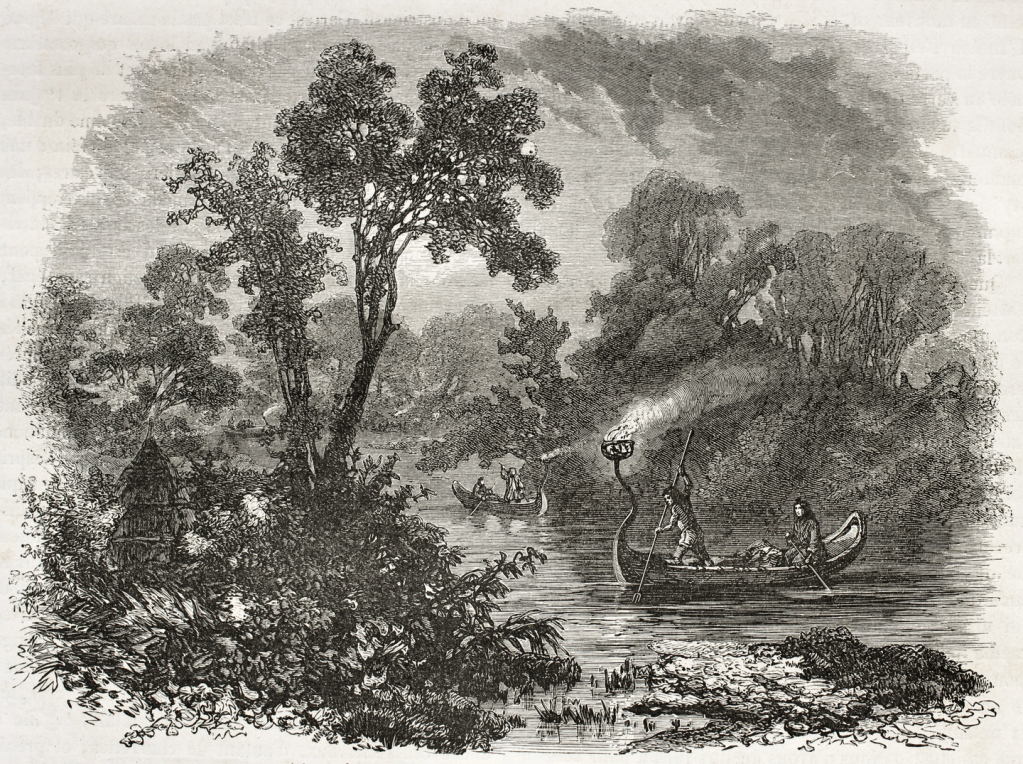
When French explorers (or Voyageurs) and fur traders arrived in the Great Lakes region in the early 1600s, they observed many indigenous tribes were making use of the bounty of fish that lived in the lakes. The earliest evidence of fishing in the Great Lakes region is 3,000 to 2,000 years old. Fish was an important food source for indigenous peoples and their ancestors. Although fishing was a year-round occupation, indigenous peoples naturally observed that some fish were more abundant at certain times of the year than at others and developed a way of life based on seasonal fishing. Many of the indigenous villages that fur traders would trade at were fishing villages such as at Mackinaw, Detroit, Chicago, Chequamegon, Sault Ste Marie, Mississauga, and at Green Bay.
The French explorers were impressed by what they observed in both the quantities of fish that Native Americans were gathering and the size of the fish themselves. They were also impressed by the wide variety of fish that was available such as Lake Trout, Whitefish, Sturgeon, Walleye, Cisco, and Atlantic Salmon. French explorers were most impressed by the Whitefish because they never encountered it before and because of its delicious flavor. Fish could also be preserved through smoking, drying, and even freezing during the winter. Another method to cook fish was to plaster the fish in clay and let it sit the coals from a fire for hours until baked. Eventually fish became an item to be traded in the fur trade. Fish could be salted, stored, and brought along as food in a voyageurs canoe.
In addition to trading goods with Native Americans, French explorers and Fur Traders also traded in knowledge. This included learning the same fishing techniques that indigenous people used so that they could also sustain themselves while exploring the wilderness. One of the methods was netting fish with a gill net. Using materials like basswood, nettle, and willow, indigenous women would weave into nets, onto which they would attach sinker stones. Net stones like this were found in the Lake Mendota canoe. The nets were sometimes dipped in a liquid made of sumac leaves to kill any odor. Indigenous men would carve floats out of wood for the net, and they would fish by positioning two canoes side by side and cast the net between them. Another method of fishing was by spearfishing, indigenous fishermen would use torches to attract fish at night and spear the fish from their canoes. When sturgeon would come into the shallows to spawn, indigenous fishermen would also spear them from either their canoes or by wading in the shallows.
Another fishing technique used on the Great lakes was the use of stone fishing weirs. Fishermen would stand in a shallow river and pile up stones to form a V shape. These would force and fish into the narrow opening where the fishermen could catch them by spear, net, or even by hand. Ancient fishing weirs like this can still be found in Wisconsin in the Crawfish River downstream from the archaeological site of Aztalan. Fur traders also observed that at the Sault Ste. Marie Rapids, indigenous fisherman would canoe out into the rapids and catch fish simply with a dip net. Lastly Fur traders learned how to ice fish from indigenous fisherman. Indigenous fisherman would carve wooden lures to attract fish to the ice fishing hole where the fish could then be speared. While the French fur traders would use a line with hooks and bait to catch fish. Ice fishing like this was observed by French fur traders in the Straits of Mackinac and in Georgian Bay in Canada.

